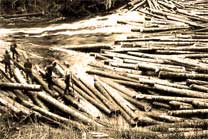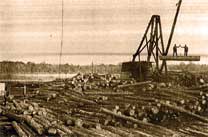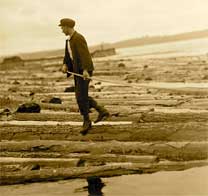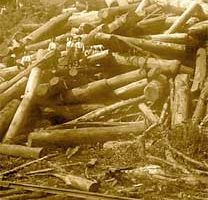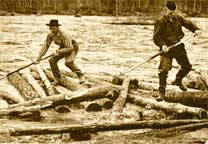History
Wood of this caliber, with growth predating the American Revolution, is quickly becoming extinct.
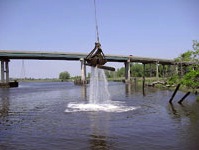
Trees cut in the early 1900’s were bound together as rafts and carefully maneuvered down the Cape Fear River to saw mills around the port city of Wilmington, North Carolina. A large number of these trees, called “sinkers,” were so dense that they sank to the bottom of the river. In a time when America was covered by plentiful forests, there was no need — or method — to retrieve these majestic trees from the depths of the river.
Today, a rich supply of these old trees remain in the sediment of the Cape Fear River, preserved in pristine condition by cool waters, devoid of oxygen. The wood is preserved in better condition than if it had been on land and once brought to the surface and milled, the rich smell of Old Growth Riverwood is still as robust as it was hundreds of years ago.
Although the vast majority of wood harvested by Old Growth Riverwood is used for hardwood flooring, the wood also is excellent for producing fine wainscoting, wall paneling, and Hand Crafted Furniture, including Coffee and End Tables, Adirondack Chairs, Counter Tops, Butcher Blocks and Cabinets.
From the 1700’s until the early 1900’s, trees were harvested and sent floating down the Cape Fear River to local mills.
The virgin forests of early America were an abundant natural resource and settlers wanted to harness the beauty, strength, and durability of Heart Pine and quickly set out to clear cut the vast forests. In order to process the timbers, they had to be shipped to the nearest sawmill and rivers were the primary means of transporting the timbers.
When a bend or a rough spot was reached on the river, many of the massive timbers were lost underwater and a large number of trees, called “sinkers”, were so dense that they sank to the bottom of the river, and in a time when America was covered by plentiful forests, there was no need or method to retrieve the trees from the depths of the river. So these lost treasures were stranded on river floors and could not be recovered… until today.
After being submerged for over a century, they have been perfectly preserved. Our historic river-preserved heart pine comes from locations throughout the Cape Fear Region in Wilmington, North Carolina and some surrounding areas. These timbers have a unique patina that newly milled timber simply cannot compete with.
The historic value and recovery process only add to it’s rare beauty. Riverwood when processed, makes unique flooring and paneling and it is also perfect for custom furniture construction and design and can be stained or left in it’s raw looking natural state.
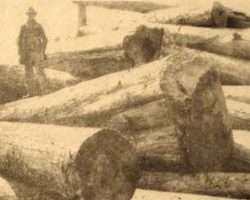
Product reclaimed wood can produce:
- Fine Paneling or Wainscoting
- Unique Ceilings
- Stair Treads and Risers
- Stair Posts and Hand Rails
- Crown or Baseboard Moldings
- Wood Siding
- Specialty Millwork for Cabinet Makers
- Custom Furniture
- and much more…
Contrary to what you might expect, most submerged lumber does not rot, due to low levels of oxygen which slows decay. There is superior quality to Riverwood when compared to factory processed new wood and, as a bonus, the material is environmentally sound, since it involves no cutting down of living trees.
All of our logs are kiln dried for stability and every log is graded and inspected to our exacting standards. Old Growth Riverwood is part of the complete process from start to finish…from log recovery, to kiln drying, to milling, product construction, and if needed, installation and finishing of our products.



